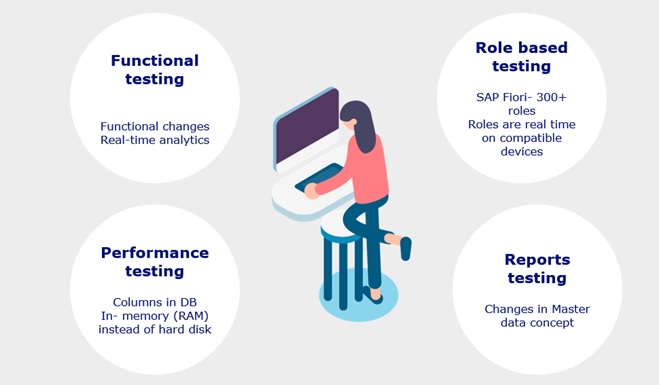4 testing recommendations for SAP S/4HANA migration testing
SAP has come a long way with SAP S/4HANA since it first launched its SAP R/3 in 1992, followed by the revised SAP ECC architecture in 2004.
With SAP S/4HANA, there are a number of architecture and technical changes, along with functional changes, to take on board. These will have a big impact on what and how you test in your SAP landscape going forwards
In this blog I will be providing recommendations around this ‘how and what’ of testing during SAP S/4HANA implementations to accommodate all the changes.
Firstly though, a quick overview of the key changes:
Architecture/technical
- HANA database
While the former 3-tier architecture system remains (Database layer, Application layer, and Presentation layer) with S/4HANA, SAP has introduced its own database – HANA. S/4HANA can ONLY be run on the HANA database, unlike SAP ECC, which can be run on MS SQL, IBM DB2, etc. databases. An in-memory computing engine allows HANA to process data stored in RAM as opposed to reading it from a disk. Put simply, it will now process a large amount of data in a very short timeframe. - SAP Fiori
SAP Fiori is the new S/4HANA dynamic user interface, providing a harmonized user experience across on premise and cloud solutions. SAP Fiori delivers a role-based, consumer-grade user experience across all lines of business, tasks, and devices. This is a browser-based user interface that can run not only on desktops and laptops, but also on mobile devices.
Functional
- Master data
A new approach to master data is among the numerous functional changes in SAP S/4HANA. With the concept of Business Partner (BP), SAP has integrated and centralized all the Customer master data and Vendor master data needs. BP will become the single point of entry to create, edit, and display master data for business partners, customers, and vendors alike. - Further changes
In addition to the new master data concept, there are many other functional changes to bear in mind in S/4HANA. These include changes to material requirements planning (MRP), an extension to the material number from 18 characters to 40, and an advanced available-to-promise (ATP) process.
4 testing recommendations for SAP S/4HANA migration testing
 With the numerous architecture and functional changes in mind, it is important to thoroughly test both new and existing features when migrating to SAP S/4HANA. Why? To ensure that business operations, systems and processes continue as usual during and after the move.
With the numerous architecture and functional changes in mind, it is important to thoroughly test both new and existing features when migrating to SAP S/4HANA. Why? To ensure that business operations, systems and processes continue as usual during and after the move.
Four key tests are recommended:
- Role-based testing
With the introduction of SAP Fiori, role-based testing has a vital role to play. There are more than 300+ roles available, all of which can be run on compatible devices. It is thus very important to test all the roles, not only on laptops and desktops, but also on all compatible mobile devices. - Functional testing
Thorough testing of all the new functions will be one of the most important aspects of SAP S/4HANA migration testing. A regression test suite can be built around the functional changes and I would urge the use of automation for this. Organizations that have already invested in automation tools can leverage these to test the new functionalities. Apart from these verifications, functional tests should also be undertaken to verify the functionality of a HANA project on multiple devices, including popular mobile platforms. - Performance testing
As SAP has introduced its own HANA database, it is important to invest some time making sure that the performance of your HANA project is well above the required performance level. Here we should stay focused on newly introduced processes and not be confused by doing performance testing of the SAP HANA database as SAP HANA delivers leading performance and scale-out ability and enables real-time BI for businesses. Rather your performance testing of the newly introduced processes should be validated by an already existing performance baseline. This will ensure that real-time data transfer is optimal for those processes. - Reports testing
With the introduction of HANA systems that notably combine real-time analytics with transactional information, verifying BI reports has become essential. In addition to verifying the accuracy of HANA-based BI reports, functional testing of those reports ensures that HANA applications and reports under test are fully functional.
In summary...
I am sure this is not the first or the last article you will read on changes and recommendations around SAP S/4HANA implementation testing. Nonetheless, I hope it offers some fresh insight into the testing needs that should be considered when migrating to SAP S/4HANA.
Please get in touch if you want to know more on this topic.
- Rohit ChandraSenior Consultant at Sogeti Finland Oy
+358408111605
 Rohit ChandraSenior Consultant at Sogeti Finland Oy
Rohit ChandraSenior Consultant at Sogeti Finland Oy
+358408111605


